Futures Wheel
AKA: Consequence Wheel, Impact Network (I prefer this term but Futures Wheel is better known)
What is it?
The Futures Wheel technique is a form of structured brainstorming intended to visualize the future direct and indirect consequences of a particular trend or event.[1, 5] However, I feel the quote below provides what is probably the best summary of the technique:
Futures Wheel is a foresight method that provides a model of the future based on the consequences of an event or trend. It is a subjective and qualitative method, relying on the experience and knowledge of the participants. Its low complexity allows its usage without requiring specialized training to be carried on. Nonetheless, it requires a deep understanding of the problem domain being analyzed, so that the generated future model may be as accurate as possible.[8]
To be clear, the term ‘consequence’ is defined as a result or effect of an action or condition
.[6]
The technique was invented by Jerome C. Glenn in 1971 while he was a student at the Antioch Graduate School of Education[1], and its main value lies in their simplicity and potential to identify a wide range of impacts very quickly. [2]
Their structure is based around a central event, with the direct and indirect consequences of that event radiating outward and linked together as appropriate. This results in a diagram that is very similar to a mind-map.
Why do it?
Futures Wheels originated with, and are primarily used by, the field of Future’s Studies (aka futurology or futurism). They are also used in Social Studies, Politics, and other fields. They have many uses in those fields, including: [4]
- Thinking through possible impacts of current trends or potential future events
- Organizing thoughts about future events or trends
- Identifying the potential consequences of a strategy
- Showing complex interrelationships
However, they can also be used in the project management, business analysis, and system / software development fields as well.
And luckily these fields are not subject to Dator’s 2nd Law of the Future, which states that Any useful idea about the future should appear to be ridiculous
.[14] Futures Studies often works on time-scales of 20-30 years. Luckily, most business analysts and project professionals are focused on much shorter time frames which allow for a more practical approach to the future where at least some factors can be reasonably guessed with some reliability.
In particular, they provide an excellent technique for eliciting non-functional requirements and functional requirements that might be reasonably implemented in order to help future-proof
a solution that is being implemented (either developed or purchased).
The real benefit of Futures Wheel’s comes when several of been created exploring different, but related, trends or events. In this case, the Business Analyst and project team can identify consequences and high-level requirements that are common across multiple options and use those consequences and high-level requirement in making their future business plans and in defining their solution design so that it can support common and likely future events and needs.
The result is a solution design and business processes that are more prepared for likely future occurrences and which are less likely to need significant changes in adapting to future business needs.
How do I do it?
Please note that the scenario used in this example is intended to be plausible, but is not highly thought out or guaranteed to be accurate. So please don’t quibble if you disagree with anything. :)
Also, the issue selected is more strategic and high-level
in hopes of making it more understandable to a broader range of readers. However, as a Business Analyst you may gain the most benefit from more executing a Futures Wheel from more mid-level or tactical decisions.
Step 1 – Define Issue
The first step in creating a future wheel is to select and refine the issue statement that will be evaluated. This is not the specific change or event to be mapped, but rather the specific context of that change.
For example, if you are an employee of an Asset Management firm that only does business in the United States; the Issue you might wish to examine could be What would be the implications of our firm expanding to offer its investment products overseas?
Step 2 – Identify Event(s)
The second step is to select one or more specific trends, events, or actions you wish to evaluate with a Futures Wheel. Each specific trend, event, or action would get its own wheel.
Continuing the example of an Asset Management firm wanting to expand outside the United States, you might identify the following potential events:
- Expand our Asset Management offerings to Australia
- Expand our Asset Management offerings to Canada
- Expand our Asset Management offerings to the EU
- Expand our Asset Management offerings to the United Kingdom
Once you have selected the event you wish to evaluate, you place the event in a circle at the center of a page, whiteboard, Visio diagram, or other similar location.
In this example I am going to use the “Expand our Asset Management offerings to the EU” option above and I am going to use Visio as my tool. This results in a circle like the one below being added to my Visio diagram to start it off.
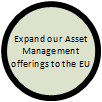
Note that the basic standard for Future Wheels does indicate you use a thicker border for the core event or trend, but as with all of these techniques the only thing that is actually important is that you can easily identify what your core event or trend is. For that purpose I have used the thicker border and added a pale-green fill to the shape.
Step 3 – Gather Appropriate Participants
Although the process can be executed by a single individual, Futures Wheels are best created by a group so that multiple perspectives and multiple areas of expertise are represented. Once you know what the exact event or trend is that you are going to investigate, the next step is to gather the appropriate participants to help with the creation of the Futures Wheel.
Note that this is done AFTER you identify the specific event so that you can gather the participant group that best supports this specific event, rather than the overall issue under consideration.
Using the event options defined in Step 2 above, you can see how I would probably want participants with region-specific Legal, Compliance, Marketing, Cultural, Investment Management, and Business knowledge at a minimum to participate in the exercise.
Step 4 – Identify Direct Consequences
The next step in the process is to brainstorm / identify only the DIRECT (or 1st-order) consequences of the event or trend being evaluated. Do not try to identify secondary (or 2nd-order) consequences of direct consequences at this time, [4] but rather keep the group focused on thinking laterally about the issue, rather than linearly.
It is important that you NOT consider how likely a consequence is to occur when adding consequences to the diagram. The only question is merely CAN a consequence occur. If it can, no matter how likely or unlikely, it should be added to the diagram.
Each direct consequence is placed in its own circle around the central event and connected to it with a single line.[4]
To keep things simple I am going to constrain my example to just 4 direct consequences, even though there would likely be many more. The updated diagram example is below:
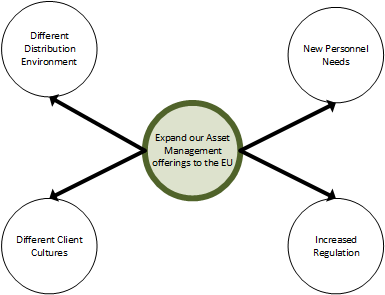
Process Variation: A variation of the standard Futures Wheel process has been proposed [12] to help guide participants. This variation is to define categories of possible consequences and allocate space around the central event for those categories. Example categories might include: Technological Impacts, Economic Impacts, Cultural Impacts, Political Impacts, Psychological Impacts, Environmental Impacts, and similar categories.
Visio Variation: Please note that the standard Future Wheel structure is that primary consequences are connected with single-lines, secondary consequences with double-lines, tertiary consequences with triple-lines, etc. However, I have not figured out how to make Visio show double or triple-line connectors so I am instead using connectors of varying thickness. With the thickest connectors being primary consequences, the next thickest secondary, etc. You could just as easily use different colors or any other method your participants agree to and that would be easily understood.
Step 5 – Identify Second-Order Consequences
Once you identified all of the direct consequences, the next step is start with a single direct consequence and identify any its direct consequences. These are dependent consequences and are essentially the consequences of the consequence.
Repeat this for all of the originally identified direct consequences, and do not try to identify any tertiary (3rd-order) consequences.[4] If you cannot identify any dependent consequences, that is OK.
I have provided an example below. As you can see from the “Local Language Skills” item, some consequences may depend from more than one higher-level consequence.
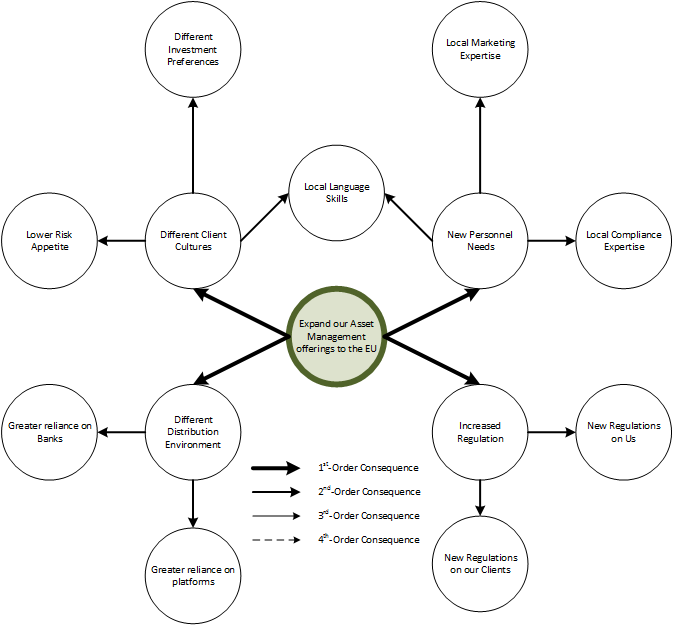
Step 6 – Identify Third-Order (and further) Impacts
The next step is to continue the process, but this time working with a single 2nd-order consequence and identifying any of its direct consequences.
Be aware that some lower-level consequences may reinforce or derive consequences that were mapped at a higher ’level’ in the diagram. For example, in the example diagram below it may be worth stating that the 3rd-order consequence of New Marketing Materials
(needed) reinforces the 1st-order consequence of New Personnel Needs
(although it’s not represented in the example in order to keep the sample diagram as simple as possible).
These types of reinforcement mechanisms are one of the great insights of Future’s Wheels because they can help you identify unexpected forces that may drive or reinforce a consequence, or make it more likely.
Repeat this step, one at a time, for all of the 2nd-order consequences, and again do not try to identify any consequences of the next level down (4th-order in this case). Hopefully, by now you are starting to see more and more consequences for which you are unable to identify any child consequences.
I have provided an example of this next step below.
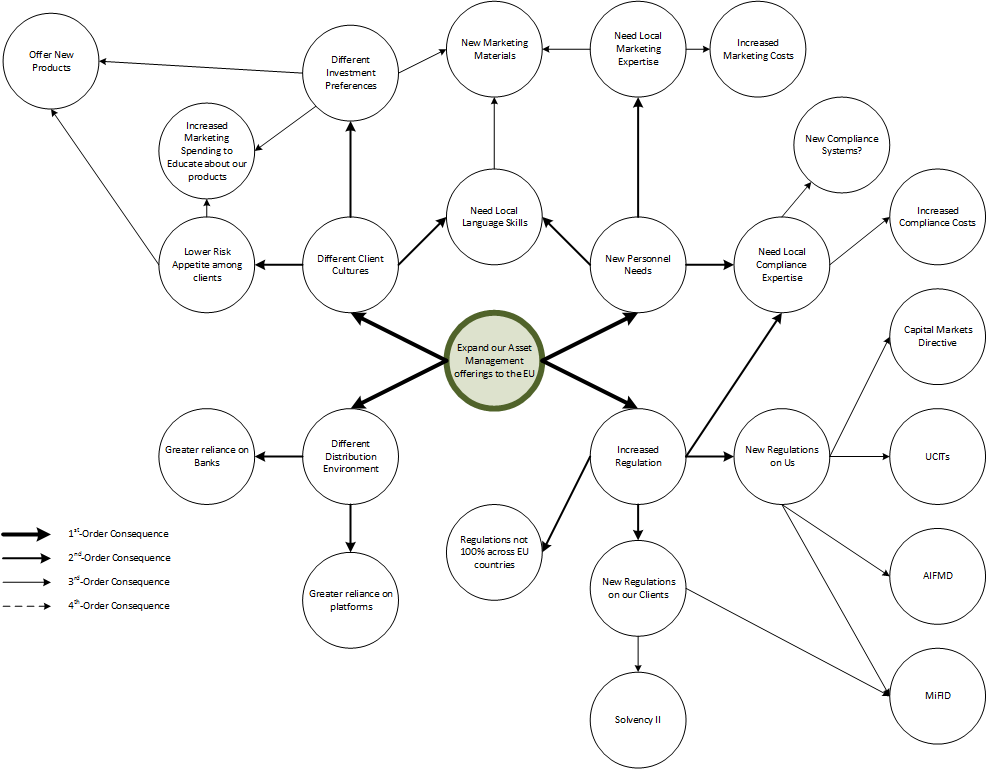
However, you should continue this process for at least the next level until you can identify no more child consequences or until your group of participants agree that no more evaluation is likely to be useful.
Usually, 3 or 4 levels of evaluation are sufficient to identify the most crucial consequences and additional levels are likely to suffer diminishing returns. Generally though, the more strategic an event is, the greater the number of levels of consequences that could be gainfully generated.
The example below is where I am going to leave off, but it should be apparent that you could continue further.
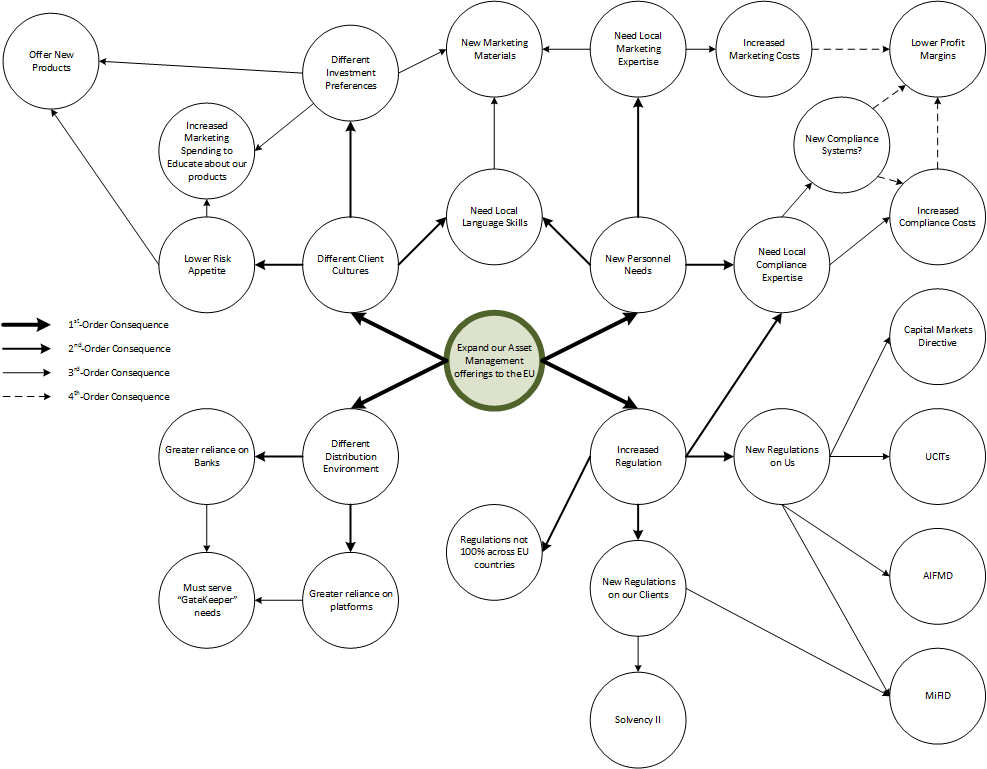
Step 7 – Analyze Implications / Define Requirements
The next step in the process is to analyze the Future Wheel diagram created up to this point in several ways.
This may involve both weighting the various implications[7] for perceived likelihood of occurrence, and for level of impact. Be aware that it may be very possible to have an implication that is unlikely but of very high impact.
Another option, which is an add-on to the standard Futures Wheel concept [see references 5 and 8], is to evaluate each node in the Wheel which has no dependent consequences and try to determine what high-level requirements would be needed for the business (or more importantly, the solution) to successfully deal with the occurrence of that consequence.
This is especially valuable in regards to high-level requirements. For example, could certain consequences trigger unexpectedly high system volumes or lead to much higher-than-expected user levels? Both examples could prove valuable in defining system scalability or performance non-functional requirements and design decisions.
Adding simple high-level requirements to the diagram results in something similar to the example below.
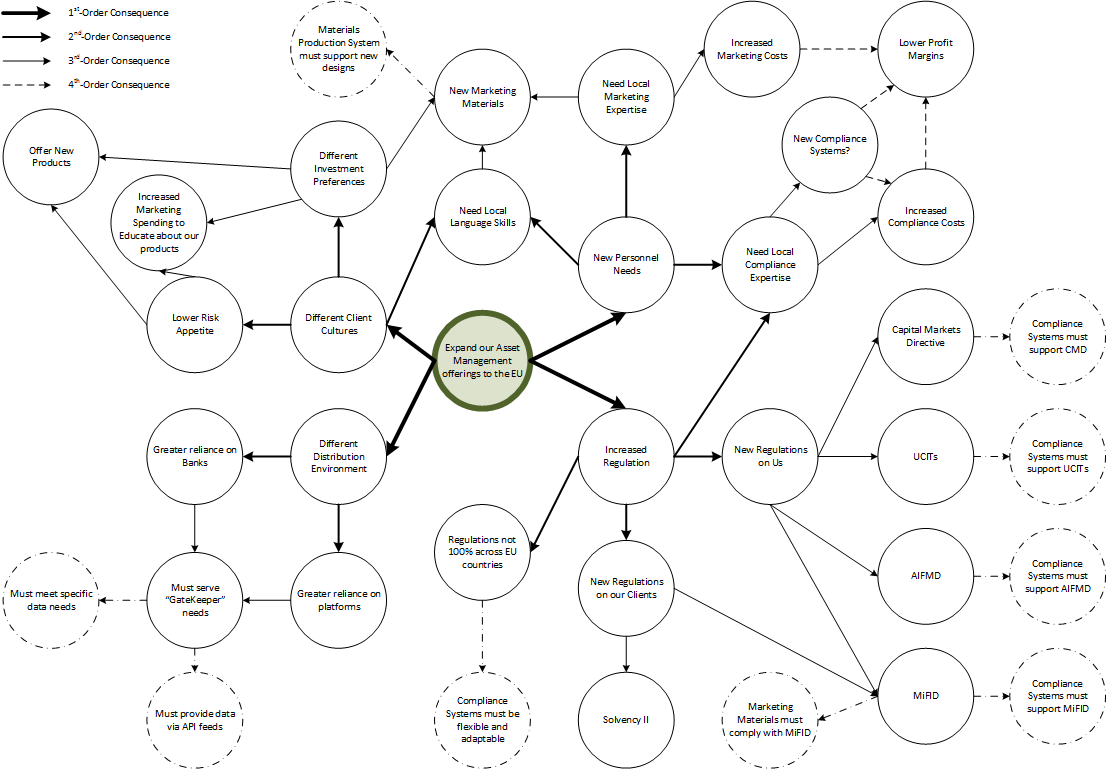
Step 8 – Identify Actions
The last step with this specific Futures Wheel is to determine which actions the group recommends be taken, if any.
This might include the adoption of specific organization plans or processes that would enable it to deal with certain consequences in a suitable manner. Or it might include the adoption of specific requirements into a project or solution specification so that any solution would be better able to deal with likely consequences of future trends or events.
Step 9 – Repeat with Additional Events or Trends
The last step of the overall process is to repeat all of the steps above with any additional events or trends within the issue under consideration that should be evaluated. For example, using our event list in Step 2 above we might also want to create Futures Wheels for the following possible events:
- Expand our Asset Management offerings to Australia
- Expand our Asset Management offerings to Canada
Or maybe you want to evaluate specific solution architecture decisions such whether to design a new application as a cloud service, or a local computer hosted-application?
The key idea is that once those additional Futures Wheels have been created to then look at all of the Wheels relating to a single issue so that broader consequence trends or common requirements or actions are identified. It is also an opportunity to revisit earlier Future Wheels to determine if consequences identified in later efforts where missed (and should be added). By identifying this common set of consequences and options, and weighting them by likelihood and impact, you can make an informed choice about organization, project or solution processes and designs that will enable you to deal with future events with the least amount of disruption.
There are no guarantees that the consequences you identify are all inclusive or even accurate, but the Futures Wheel process at least gives you a method for looking into the future in a structured way in order to identify potential impacts to your organization. And really, you can’t ask for much more than that when it comes to thinking about the future.
What Should the Results be?
The final result could look something like the example below. Or you might want to look at an example [10] created for an article [9] on PBS.org.

Advantages
- The Futures Wheel technique …
Adds rigor by helping people think through how an issue may unfold or the consequences of an event or strategy in a thorough fashion. Avoids one-dimensional, linear thinking. Helps move the mind from linear, hierarchical and simplistic thinking to more network-oriented, organic and complex thinking. Helps identify relationships and unintended consequences.
[4]
Disadvantages
- A completed Futures Wheel essentially serves as a Rorschach test of the authoring group or the organization that were involved in its creation because the members of the group are most likely to identify impacts highlighting areas of concern.[2] This bias is a result of the process and is best mitigated by having participants with a wide-range of concerns, responsibilities, and expertise.
While the Futures Wheel method is easily grasped by participants, an undisciplined approach can result in what is referred to as
[11]intellectual spaghetti
i.e. the generation of a myriad of interactions that become so complex that they tend to complicate and confuse the implications of the trend. This method is limited to the knowledge of the participants and while information overload can occur, confining analysis to the primary, secondary and tertiary rings, allows for the visualization of a vast amount of qualitative information that has both depth and contextual richness.
Tips
- You should try to generate at least 5 to 7 primary consequences, and at least 3 secondary consequences from each of those. Make sure you push changes to their extreme, if logical, conclusions.[13]
- Most Mind-Mapping software could be used to easily create a Futures Wheel. Diagramming packages such as Visio could also be used, although with less ease.
IT IS CRITICAL THAT EACH IMPACT RING OF THE WHEEL IS COMPLETED BEFORE MOVING ON TO THE NEXT.
[4]TIP: to identify impacts or consequences ask: (1) If this happens, then what happens next? Or (2) What goes with this event or trend? Or (3) What are the impacts or consequences?
[4]
References
- Wikipedia Article: Futures Wheel. By Various Authors. Accessed on May 5, 2015.
- Report: Futures Research and the Strategic Planning Process – Implications for Higher Education. Chapter: The Stages of the Strategic Planning Process. By James L. Morrison, William L. Renfro, and Wayne I. Boucher. ASHE-ERIC Higher Education Research Reports. 1984. Available online:
- Article: The Futures Wheel – Identifying Future Consequences of a Change. By Ruth Hill. Available on the MindTools.com web site.
- Article: Consequence Wheels / Futures Wheels. By Emergent Futures. 2009.
- Research Paper: Anticipating Requirements Changes – Using Futurology in Requirements Elicitation. By Pimentel, Santos, Castro, and Franch. Universidade Federal de Pernambuco, Brazil.
- Definition: Consequence. Google. Accessed on May 8, 2015.
- Definition: Implication. Google. Accessed on May 8, 2015.
- Research Paper: Towards Anticipating Requirements Changes through Studies of the Future. By Pimentel, Santos, Castro, and Franch. Universidade Federal de Pernambuco, Brazil.
- Article: What if the New York Times Ended Its Daily Print Edition? By Steve Outing. June 23, 2014. PBS.org.
- Larger image for above:
- Research Paper: Conceiving an Army for the 21st Century. By Michael A. Rostek, Peter Gizewski, and Regan Reshke. Defense R&D Canada – Center for Operational Research and Analysis. December 2010.
- Research Paper: REfIS – A Stage-based Methodology for Eliciting Requirements. By Felipe Ferraz, Leopoldo Ferreira, Rodrigo Assad, Renato Ferreira, and Silvio Meira. 2011.
- Research Paper: Manoa – The future is not binary. By Wendy Schultz. APF Compass. April 2015.
- Article: What Futures Studies Is, and Is Not. By Jim Dator. University of Hawaii, Hawaii Research Center for Futures Studies. 2007.
Related Resources
- Article: Relevance Trees & Futures Wheels. By Jim Flowers. Ball State University. October 1, 2013.
- Article: Futures Wheel Exercise. By William Knoke. 2012.
- Article: Futures Wheel. On the Skills Converged website.